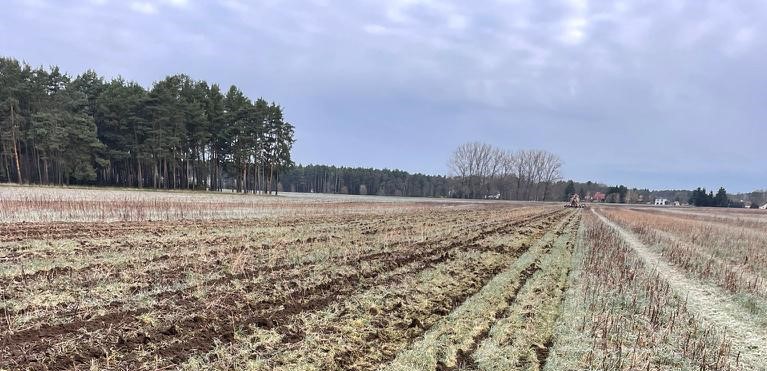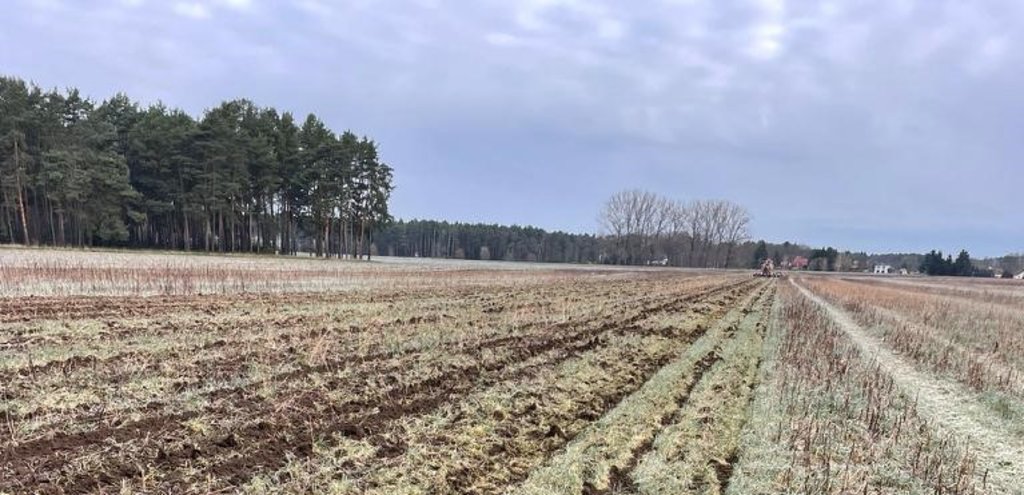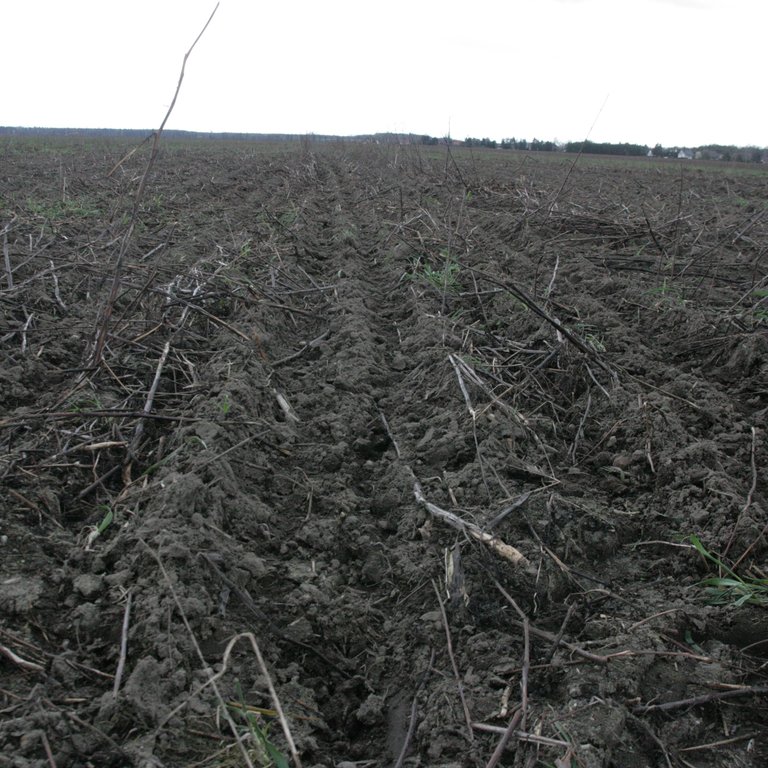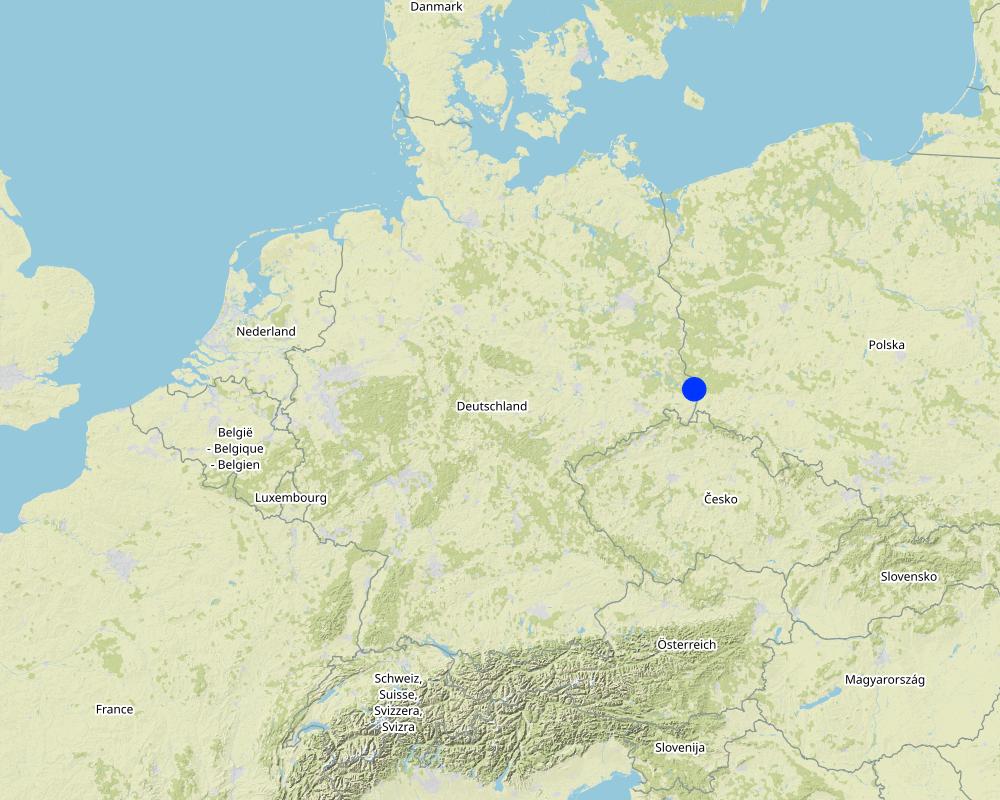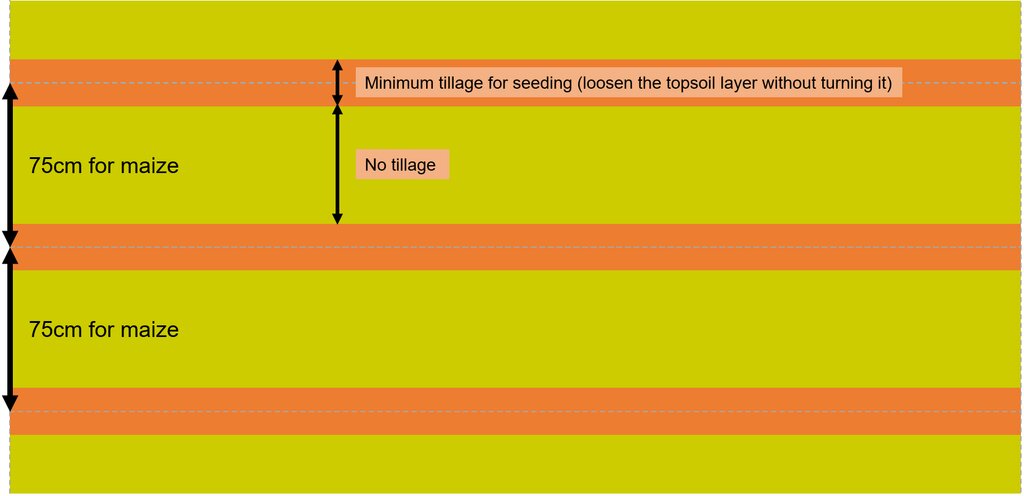Strip-till [Germany]
- Creation:
- Update:
- Compiler: Felix Witing
- Editors: Michael Strauch, Mona Pauer
- Reviewers: William Critchley, Rima Mekdaschi Studer
Streifenbearbeitung
technologies_6257 - Germany
View sections
Expand all Collapse all1. General information
1.2 Contact details of resource persons and institutions involved in the assessment and documentation of the Technology
SLM specialist:
SLM specialist:
Name of project which facilitated the documentation/ evaluation of the Technology (if relevant)
OPtimal strategies to retAIN and re-use water and nutrients in small agricultural catchments across different soil-climatic regions in Europe (OPTAIN)Name of the institution(s) which facilitated the documentation/ evaluation of the Technology (if relevant)
Helmholtz Centre for Environmental Research (UFZ) - Germany1.3 Conditions regarding the use of data documented through WOCAT
The compiler and key resource person(s) accept the conditions regarding the use of data documented through WOCAT:
Yes
1.4 Declaration on sustainability of the described Technology
Is the Technology described here problematic with regard to land degradation, so that it cannot be declared a sustainable land management technology?
No
2. Description of the SLM Technology
2.1 Short description of the Technology
Definition of the Technology:
Strip-till is a form of precision farming and conservation agriculture that combines minimum tillage in strips with no-till on the remainder of the field. The soil over the whole field is protected by a growing crop or mulch from sunlight, and especially from the direct impact of raindrops by providing permanent soil cover.
2.2 Detailed description of the Technology
Description:
Conservation agriculture includes cultivation systems with minimum tillage or without tillage (no-till). Minimum tillage uses machinery (cultivators, rotary tillers) that only loosen the topsoil layer without turning it, leaving a mixture of bare soil and crop residues from the previous crop/ cover crop on the surface. No-till refers to sowing and fertilizing directly into the plant residues. Strip-till is a hybrid, where only the strip around the seed furrow is minimum-tilled, leaving up to two-thirds of the area under no-till.
Strip-till increases surface roughness, which slows the flow of surface water after heavy rains, improving infiltration rates and particle deposition, thus preventing soil erosion, nutrient losses and degradation of water quality in downstream channels and rivers. The plant residues reduce soil crust formation and decrease evaporation rates (Gangan et al. 2022). The residues also improve biological activity and the build-up of soil organic matter (SOM) and clay-humus complexes. The increased SOM content improves water storage capacity and thus water use efficiency throughout the growing season (Stadler, 2014; Busari et al. 2015).
Strip-till seeding is a precision farming technology that requires a high precision GPS guidance system and specific machinery, such as seed drills to cut through crop residues. The distance beween the strips depends on the cultivated crop. For maize cultivation it is typically 75cm. Strip-till machinery is often heavier than conventional seeding drills because the undisturbed soil is denser and harder. Often a new tractor with more horsepower is needed to compensate for the heavy weights. If mulch seeding is used, grain harvesters equipped with well-designed straw/chaff spreading devices across the full cutting width are required (Corsi & Muminjanov, 2019).
Strip-till also has negative side effects, which are related to the disadvantages of no-till: delayed soil warming, soil compaction, increased disease pressure, and increased weed pressure. Without ploughing, other measures such as selecting fast-growing and effective ground cover species, early high-density seeding, and/or using herbicides are needed to control weeds, especially in the transition period (first 2-3 years) when the seed bank in the soil is well-filled.
In our documented example, the farmer used strip-till on sandy soils (lacking nutrients, with poor water-holding capacity) and combined it with the application of organic fertilizer. Specifically the strip-till seeding of maize was chosen to make efficient use of digestate from a biogas plant. The digestate is applied in the tilled strips (seed bed) providing organic fertilizer for the whole growing season. A winter-killed catch crop was sown before drilling maize. The technology required expensive machinery and equipment, such as a Volmer Strip-Till Culex ML, RTK station and GPS guidance system. However, the costs were recouped through savings in fuel and fertilizer.
2.3 Photos of the Technology
2.5 Country/ region/ locations where the Technology has been applied and which are covered by this assessment
Country:
Germany
Region/ State/ Province:
Saxony
Further specification of location:
Uhsmannsdorf (Nieder Horka)
Specify the spread of the Technology:
- evenly spread over an area
If precise area is not known, indicate approximate area covered:
- 1-10 km2
Is/are the technology site(s) located in a permanently protected area?
No
Map
×2.6 Date of implementation
If precise year is not known, indicate approximate date:
- 10-50 years ago
2.7 Introduction of the Technology
Specify how the Technology was introduced:
- through land users' innovation
Comments (type of project, etc.):
The farmer wanted to have a system to effectively incorporate biogas residues.
3. Classification of the SLM Technology
3.1 Main purpose(s) of the Technology
- improve production
- reduce, prevent, restore land degradation
- adapt to climate change/ extremes and its impacts
- create beneficial economic impact
- To effectively incorporate biogas residues.
3.2 Current land use type(s) where the Technology is applied
Land use mixed within the same land unit:
No

Cropland
- Annual cropping
Annual cropping - Specify crops:
- cereals - maize
- cereals - rye
- Winter-killed cover crop (e.g. mustard) before maize
Number of growing seasons per year:
- 1
Is intercropping practiced?
No
Is crop rotation practiced?
Yes
If yes, specify:
silage maize, rye, rye
3.3 Has land use changed due to the implementation of the Technology?
Has land use changed due to the implementation of the Technology?
- No (Continue with question 3.4)
3.4 Water supply
Water supply for the land on which the Technology is applied:
- rainfed
3.5 SLM group to which the Technology belongs
- improved ground/ vegetation cover
- minimal soil disturbance
- integrated soil fertility management
3.6 SLM measures comprising the Technology

agronomic measures
- A1: Vegetation/ soil cover
- A2: Organic matter/ soil fertility
- A3: Soil surface treatment
- A6: Residue management
A3: Differentiate tillage systems:
A 3.2: Reduced tillage (> 30% soil cover)
A6: Specify residue management:
A 6.4: retained
3.7 Main types of land degradation addressed by the Technology

soil erosion by water
- Wt: loss of topsoil/ surface erosion
- Wg: gully erosion/ gullying

soil erosion by wind
- Et: loss of topsoil
- Ed: deflation and deposition

chemical soil deterioration
- Cn: fertility decline and reduced organic matter content (not caused by erosion)

physical soil deterioration
- Pc: compaction
- Pk: slaking and crusting
- Pu: loss of bio-productive function due to other activities

biological degradation
- Bc: reduction of vegetation cover
- Bh: loss of habitats
- Bl: loss of soil life

water degradation
- Ha: aridification
- Hs: change in quantity of surface water
- Hp: decline of surface water quality
3.8 Prevention, reduction, or restoration of land degradation
Specify the goal of the Technology with regard to land degradation:
- prevent land degradation
- reduce land degradation
4. Technical specifications, implementation activities, inputs, and costs
4.1 Technical drawing of the Technology
Technical specifications (related to technical drawing):
*1: Direct seeding is quite similar to strip-till
Author:
Schmidt et al. (2001)
Technical specifications (related to technical drawing):
The distance between the strips depends on the cultivated crop. For maize cultivation it is typically 75cm. For other row-crops (e.g. sugar beet) or rapeseed the distance between the tilled strips can be lower.
Author:
Felix Witing
Date:
07/08/2023
4.2 General information regarding the calculation of inputs and costs
Specify how costs and inputs were calculated:
- per Technology area
Indicate size and area unit:
1 ha
other/ national currency (specify):
€
If relevant, indicate exchange rate from USD to local currency (e.g. 1 USD = 79.9 Brazilian Real): 1 USD =:
0.91
Indicate average wage cost of hired labour per day:
18.70€ per hour
4.3 Establishment activities
| Activity | Timing (season) | |
|---|---|---|
| 1. | Equipment purchase | |
| 2. | Installation of precision farming technology (RTK station, GPS guidance system) |
4.4 Costs and inputs needed for establishment
| Specify input | Unit | Quantity | Costs per Unit | Total costs per input | % of costs borne by land users | |
|---|---|---|---|---|---|---|
| Equipment | GPS-guidance system | GPS-guidance system | 1.0 | 25000.0 | 25000.0 | 100.0 |
| Equipment | Volmer Strip-till Culex ML | Vomer Strip-till Culex ML | 1.0 | 25000.0 | 25000.0 | 100.0 |
| Equipment | RTK-station | RTK-station | 1.0 | 17500.0 | 17500.0 | 100.0 |
| Total costs for establishment of the Technology | 67500.0 | |||||
| Total costs for establishment of the Technology in USD | 74175.82 | |||||
If land user bore less than 100% of costs, indicate who covered the remaining costs:
Farmer stated that it is complicated to get subsidies. He said: "equipment subsidies are like a lottery".
Comments:
There are no details available about the operating life of the machinery - thus no "per hectare per year" calculation can be estimated.
4.5 Maintenance/ recurrent activities
| Activity | Timing/ frequency | |
|---|---|---|
| 1. | Spreading biogas digestate | March/April |
| 2. | Combined strip-till | April/May |
| 3. | Weed bonitour | June |
| 4. | Crop protection measure | June |
| 5. | Silage | September/October |
| 6. | Transport to biogas plant | September/October |
4.6 Costs and inputs needed for maintenance/ recurrent activities (per year)
If you are unable to break down the costs in the table above, give an estimation of the total costs of maintaining the Technology:
-73.0
If land user bore less than 100% of costs, indicate who covered the remaining costs:
80€/ha are covered by the state of saxony, AL_2 Strip seeding/ direct seeding (SMUL Sachsen, 2015)
Comments:
According to the farmer, there are few additional costs to maintain the technology, but there are savings in diesel, labor, etc., resulting in total savings of approx. -73€/ha.
It is not possible for external experts (given the information available) to calculate, independently, the annual costs with any reliability.
4.7 Most important factors affecting the costs
Describe the most determinate factors affecting the costs:
If the work is done by a contracting company, the costs are 10-20% higher.
5. Natural and human environment
5.1 Climate
Annual rainfall
- < 250 mm
- 251-500 mm
- 501-750 mm
- 751-1,000 mm
- 1,001-1,500 mm
- 1,501-2,000 mm
- 2,001-3,000 mm
- 3,001-4,000 mm
- > 4,000 mm
Specify average annual rainfall (if known), in mm:
739.00
Indicate the name of the reference meteorological station considered:
https://whh-kliwes.de/mapview
Agro-climatic zone
- humid
- sub-humid
Length of growing period (LGP): 209
(https://www.umwelt.sachsen.de/dauer-der-vegetationsperiode-30631.html)
5.2 Topography
Slopes on average:
- flat (0-2%)
- gentle (3-5%)
- moderate (6-10%)
- rolling (11-15%)
- hilly (16-30%)
- steep (31-60%)
- very steep (>60%)
Landforms:
- plateau/plains
- ridges
- mountain slopes
- hill slopes
- footslopes
- valley floors
Altitudinal zone:
- 0-100 m a.s.l.
- 101-500 m a.s.l.
- 501-1,000 m a.s.l.
- 1,001-1,500 m a.s.l.
- 1,501-2,000 m a.s.l.
- 2,001-2,500 m a.s.l.
- 2,501-3,000 m a.s.l.
- 3,001-4,000 m a.s.l.
- > 4,000 m a.s.l.
Indicate if the Technology is specifically applied in:
- not relevant
5.3 Soils
Soil depth on average:
- very shallow (0-20 cm)
- shallow (21-50 cm)
- moderately deep (51-80 cm)
- deep (81-120 cm)
- very deep (> 120 cm)
Soil texture (topsoil):
- coarse/ light (sandy)
Soil texture (> 20 cm below surface):
- medium (loamy, silty)
Topsoil organic matter:
- medium (1-3%)
If available, attach full soil description or specify the available information, e.g. soil type, soil PH/ acidity, Cation Exchange Capacity, nitrogen, salinity etc.
Eroded gleysol
5.4 Water availability and quality
Ground water table:
< 5 m
Availability of surface water:
medium
Water quality (untreated):
poor drinking water (treatment required)
Water quality refers to:
surface water
Is water salinity a problem?
No
Is flooding of the area occurring?
No
5.5 Biodiversity
Species diversity:
- medium
Habitat diversity:
- low
5.6 Characteristics of land users applying the Technology
Sedentary or nomadic:
- Sedentary
Market orientation of production system:
- commercial/ market
Off-farm income:
- 10-50% of all income
Relative level of wealth:
- average
- rich
Individuals or groups:
- groups/ community
Level of mechanization:
- mechanized/ motorized
Gender:
- women
- men
Age of land users:
- middle-aged
5.7 Average area of land used by land users applying the Technology
- < 0.5 ha
- 0.5-1 ha
- 1-2 ha
- 2-5 ha
- 5-15 ha
- 15-50 ha
- 50-100 ha
- 100-500 ha
- 500-1,000 ha
- 1,000-10,000 ha
- > 10,000 ha
Is this considered small-, medium- or large-scale (referring to local context)?
- large-scale
Comments:
2500 ha
5.8 Land ownership, land use rights, and water use rights
Land ownership:
- individual, not titled
Land use rights:
- leased
- individual
Water use rights:
- communal (organized)
Are land use rights based on a traditional legal system?
No
5.9 Access to services and infrastructure
health:
- poor
- moderate
- good
education:
- poor
- moderate
- good
technical assistance:
- poor
- moderate
- good
employment (e.g. off-farm):
- poor
- moderate
- good
markets:
- poor
- moderate
- good
energy:
- poor
- moderate
- good
roads and transport:
- poor
- moderate
- good
drinking water and sanitation:
- poor
- moderate
- good
financial services:
- poor
- moderate
- good
6. Impacts and concluding statements
6.1 On-site impacts the Technology has shown
Socio-economic impacts
Production
crop production
Comments/ specify:
Effective use of the organic fertilizer (biogas digestate) and improvement of soil quality (sandy soils).
crop quality
risk of production failure
Comments/ specify:
Increased water holding capacity on the long term.
Income and costs
expenses on agricultural inputs
Comments/ specify:
Can efficiently use organic fertilizer (biogas digestate).
farm income
Comments/ specify:
Increase due to savings of diesel and labor.
diversity of income sources
workload
Comments/ specify:
Fewer working operations.
Ecological impacts
Water cycle/ runoff
surface runoff
Comments/ specify:
Increased infiltration rates
Soil
soil moisture
Comments/ specify:
Improved soil moisture due to increased infiltration and less transpiration (improved soil cover)
soil cover
soil loss
soil compaction
soil organic matter/ below ground C
Biodiversity: vegetation, animals
pest/ disease control
Comments/ specify:
Due to combination with winter-freezing cover crops.
Climate and disaster risk reduction
drought impacts
Specify assessment of on-site impacts (measurements):
The assessment is based on the response of the interviewed farmer and not based on on-site measurements.
6.2 Off-site impacts the Technology has shown
water availability
downstream flooding
Comments/ specify:
Reduced due to less surface runoff.
groundwater/ river pollution
Comments/ specify:
Reduced due to less surface runoff and efficient application of fertilizers.
wind transported sediments
Comments/ specify:
Reduced due to improves soil cover.
Specify assessment of off-site impacts (measurements):
The assessment is based on expert judgement of the compiler and not based on local measurements.
6.3 Exposure and sensitivity of the Technology to gradual climate change and climate-related extremes/ disasters (as perceived by land users)
Gradual climate change
Gradual climate change
| Season | increase or decrease | How does the Technology cope with it? | |
|---|---|---|---|
| other gradual climate change | Changing weather conditions | increase | well |
Climate-related extremes (disasters)
Climatological disasters
| How does the Technology cope with it? | |
|---|---|
| heatwave | well |
Comments:
The changing weather conditions lead to a higher motivation and higher willingness to invest.
6.4 Cost-benefit analysis
How do the benefits compare with the establishment costs (from land users’ perspective)?
Short-term returns:
negative
Long-term returns:
positive
How do the benefits compare with the maintenance/ recurrent costs (from land users' perspective)?
Short-term returns:
neutral/ balanced
Long-term returns:
positive
6.5 Adoption of the Technology
- 1-10%
Of all those who have adopted the Technology, how many did so spontaneously, i.e. without receiving any material incentives/ payments?
- 91-100%
Comments:
The farmer adopted the technology without receiving subsidy for the machinery and precision farming technology. However, with the most recent subsidy systems it is possible to get hectare-based payments for applying strip-till.
6.6 Adaptation
Has the Technology been modified recently to adapt to changing conditions?
No
6.7 Strengths/ advantages/ opportunities of the Technology
| Strengths/ advantages/ opportunities in the land user’s view |
|---|
| Economically beneficial. |
| Savings of operations in sowing and tillage. |
| Higher soil moisture, improved water-use-efficiency through the whole growing season. |
| Strengths/ advantages/ opportunities in the compiler’s or other key resource person’s view |
|---|
| Less erosion (less bare soil). |
| Higher water infiltration rates (more macro- and mesopores due to roots and improved biological activities). |
| Improved soil health and quality. Plant residues/cover crops increase biological activity, such as the presence of earthworms that digest plant residues into clay-humus-complexes, improving soil structure. |
| Greater planting time flexibility. The new crop can be sown as soon as the previous crop is harvested and weather conditions are suitable. |
6.8 Weaknesses/ disadvantages/ risks of the Technology and ways of overcoming them
| Weaknesses/ disadvantages/ risks in the land user’s view | How can they be overcome? |
|---|---|
| Component failure of the technology: it is quite susceptible to interference during data transmission. | Thus, in Germany, for example, better grid development is needed. |
| Weaknesses/ disadvantages/ risks in the compiler’s or other key resource person’s view | How can they be overcome? |
|---|---|
| Increased weed pressure. | However, this often occurs only in the first few years. Planting of cover crops can suppress weeds. |
| Increased disease pressure. | Can be overcome by diverse crop rotation without direct repetitions (e.g. wheat-wheat, or maize-maize). Grinding of residues for faster decomposition. |
| Delayed soil warming- | Adjustment can include underfoot fertilization as well as injection fertilization. |
7. References and links
7.1 Methods/ sources of information
- field visits, field surveys
1
- interviews with land users
1
- compilation from reports and other existing documentation
When were the data compiled (in the field)?
16/03/2023
7.2 References to available publications
Title, author, year, ISBN:
Corsi, S. and Muminjanov, H. (2019): Conservation Agriculture: Training guide for extension agents and farmers in Eastern Europe and Central Asia. Rome, FAO.
Available from where? Costs?
https://www.fao.org/sustainable-agricultural-mechanization/resources/publications/details/ar/c/1195731/
7.3 Links to relevant online information
Title/ description:
Busari et al. (2015): Conservation tillage impacts on soil, crop and the environment. International Soil and Water Conservation Research 3(2)
URL:
https://doi.org/10.1016/j.iswcr.2015.05.002
Title/ description:
Stadler (2014): Mulchsaat zu Mais- das „Wie“ entscheidet. LfL
URL:
https://www.lfl.bayern.de/mam/cms07/iab/dateien/mais_2-2014_stadler_mulchsaat2.pdf
Title/ description:
Gangan et al. (2022): Effect of raindrop splashes on topsoil structure and infiltration characteristics. CATENA 212
URL:
https://doi.org/10.1016/j.catena.2022.106040
Title/ description:
Schmidt et al. (2001): Conservation tillage - A new strategy in flood control. 287-293. In J. Marsalek et al.: Advances in urban stormwater and agricultural runoff source controls. quoted in: LfULG- Landesamt für Umwelt; Landwirtschaft und Geologie: Direktsaat.
URL:
https://www.landwirtschaft.sachsen.de/direktsaat-19689.html
Title/ description:
SMUL Sachsen (2015): Förderperiode 2014-2020- Art. 28 der Verordnung (EU) Nr. 1305/2013 - Richtlinie Agrarumwelt- und Klimamaßnahmen (RL AUK/2015)-Sächsisches Agrarumwelt- und Naturschutzprogramm (AUNaP)
URL:
https://www.smul.sachsen.de/lfulg/download/AUK-Massnahmen-Ueberblick.pdf
Links and modules
Expand all Collapse allLinks
No links
Modules
No modules


